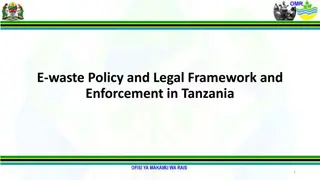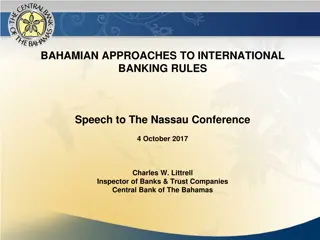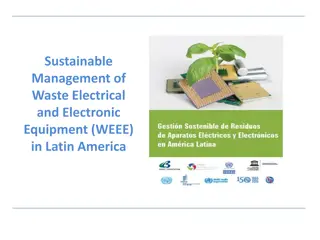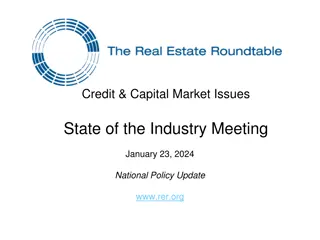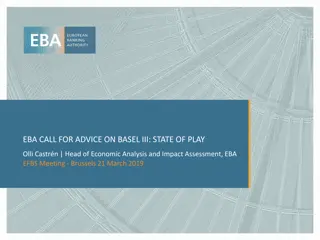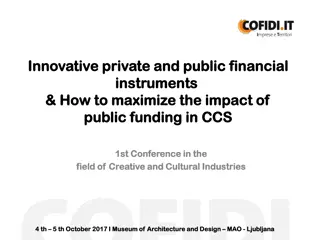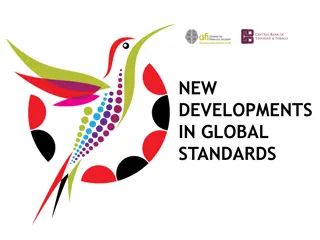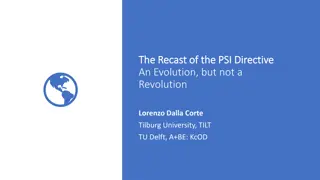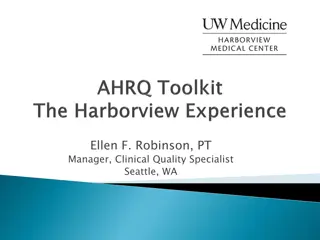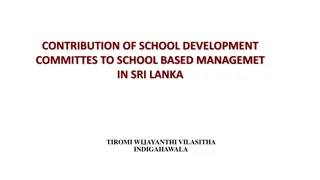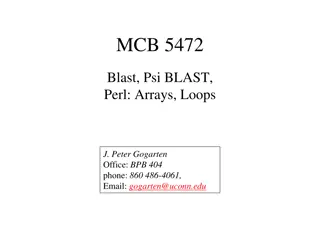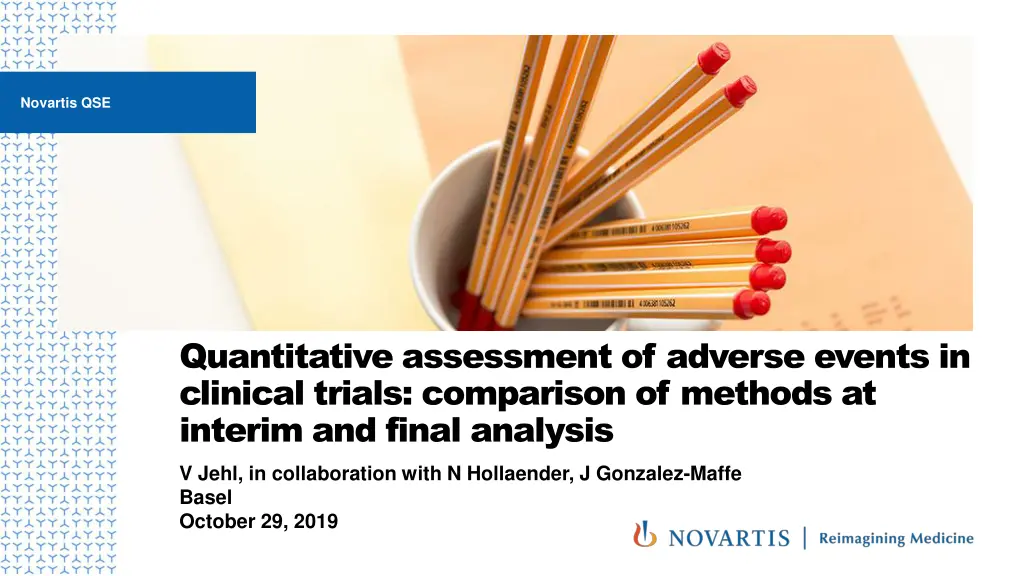
Quantitative Assessment of Adverse Events in Clinical Trials
Explore different methods to estimate the probability of adverse event occurrences in clinical trials, with a focus on early safety interim analysis. The study compares various approaches to assess adverse events and competing events for data monitoring committees. Additionally, definitions for adverse events and competing events are discussed to provide clarity in clinical trial reporting.
Download Presentation

Please find below an Image/Link to download the presentation.
The content on the website is provided AS IS for your information and personal use only. It may not be sold, licensed, or shared on other websites without obtaining consent from the author. If you encounter any issues during the download, it is possible that the publisher has removed the file from their server.
You are allowed to download the files provided on this website for personal or commercial use, subject to the condition that they are used lawfully. All files are the property of their respective owners.
The content on the website is provided AS IS for your information and personal use only. It may not be sold, licensed, or shared on other websites without obtaining consent from the author.
E N D
Presentation Transcript
Novartis QSE Quantitative assessment of adverse events in clinical trials: comparison of methods at interim and final analysis V Jehl, in collaboration with N Hollaender, J Gonzalez-Maffe Basel October 29, 2019
Disclaimer The views and opinions expressed in this presentation are those of the authors and do not necessarily reflect the official policy or position of Novartis or any of its officers. 2 PSI Basel 29OCT2019
Objective Compare different methods to estimate the probability of occurrence of a selected adverse event (AE) Particular focus Early safety interim analysis (IA) for data monitoring committee (DMC) when limited knowledge about safety drug profile Competing event (CE) 3 PSI Basel 29OCT2019
Setting In clinical study reports (CSRs), AEs are commonly summarized using the incidence proportion (IP) (0 to 1) or equivalently incidence frequency (0-100%) To account for possible different follow-up time between patients, time-to- event methods are often employed: one-minus-Kaplan-Meier (1-KM) is known to overestimate the AE probability in the presence of competing events Non-parametric estimator of the cumulative incidence function (CIF) is therefore advocated Do these methods reasonably estimate the AE probability at time of IA, when DMC needs to take decision on safety of the drug? we investigate this via a case study and simulations 4 PSI Basel 29OCT2019
Adverse event & Competing event Definition Adverse event (AE) Any type of undesirable effect reported in context of clinical trial Assumed well defined using MedDRA hierarchy (preferred term or grouping of preferred terms) Denoted here as AE , same principles apply to AE of particular severity or seriousness, vital sign or ECG finding Competing Event (CE) An event whose occurrence either precludes the occurrence of another event under examination or fundamentally alters the probability of this other event Gooley et al. (1999) In most clinical trials, permanent drug discontinuation results in stopping the safety data collection Thus the occurrence of permanent drug discontinuation prevents the observation of AE at a later timepoint Permanent drug discontinuation (irrespective of cause, including death) treated as one combined CE 5 PSI Basel 29OCT2019
Methods compared & definitions Indexing by k, the event type k=AE or k=CE ??(t): #pat. experiencing the event k at any time before time t N: total #pat. at start of study Incidence proportion at time t (IP) ??(?) ? ??? : Kaplan-Meier estimator for event k at time t When event k is the AE, the AE is counted as an event, patients experiencing the CE (without prior AE) are censored One minus Kaplan-Meier at time t (1-KM) 1-??(?) S(?? 1): Kaplan-Meier estimator for the composite endpoint (AE or CE) at time ?? 1, ???: #pat. experiencing event k at time point ??, ??: #pat. under observation before timepoint ?? ???: incidence density for event k i.e. ??: #pat. experiencing event k ??: population time (person-time) at risk ????? = ???? + ???? Cumulative incidence function (Aalen-Johansen estimator) at time t (CIF) ?? ??(?? 1)??? ?? Parametric estimator based on the incidence density taking CE into account at time t (PCIF) ?? ?? ??? ?????(1-exp(-t * ?????)) #pat.= number of patients 6 PSI Basel 29OCT2019
Case Case study study
Case study (1/5) a phase III study in breast cancer study AE: most commonly observed AE - stomatitis Stomatitis is defined as a Grouping of Preferred Terms in MedDRA Mostly occurring within first 56 days of study treatment At CSR, 321 patients out of 482 reported stomatitis (IPAE=0.67) CE Permanent discontinuation from study treatment including death Per protocol, safety reported up to 28 days after last dose intake At CSR, 117 patients out of 482 had a CE without prior AE(IPCE=0.24) Follow-up time for study Driven by primary efficacy endpoint (progression-free-survival): until sufficient number of PFS events to achieve pre-specified power i.e. irrespective of safety Individual treatment duration: until disease progression, toxicity or cut-off date for primary analysis Median exposure time 168 days (range: 7 to 703) 8 PSI Basel 29OCT2019
Case study (2/5) Final study results At max follow-up (FU) time, IP and CIF similar results 1-KM and PCIF provide a higher estimate than IP and CIF Max FU time 9 PSI Basel 29OCT2019
Case study (3/5) We now introduce an interim analysis (IA) 180 days after the first patient enrolled (i.e. Typical DMC situation) What can the DMC say about the risk of stomatitis at that point in time? Note: this IA did not exist in the considered study but was re-analyzed for the purpose of this investigational work 10 PSI Basel 29OCT2019
Case study (4/5) IA vs. Final study results N=89 (#AE=67 #CE=4 #Cens=18) N=482 (#AE=321 #CE=117 #Cens=44) 11 PSI Basel 29OCT2019
Case study (4/5) IA vs. Final study results N=89 (#AE=67 #CE=4 #Cens=18) N=482 (#AE=321 #CE=117 #Cens=44) So what is THE probability of stomatitis? How can a DMC take decisions on the safety profile? What is the impact of CE distribution? What is the impact of AE distribution? 12 PSI Basel 29OCT2019
Objective - revisited Compare different methods to estimate the probability of occurrence of a selected adverse event (AE) Particular focus Early safety interim analysis (IA) for data monitoring committee (DMC) when limited knowledge about safety drug profile Competing event (CE) Investigate impact of AE and CE hazard function distribution We model hazards using Weibull distributions 13 PSI Basel 29OCT2019
Simulation Simulation study study
Investigate Investigate AE Illustration 1: AE Illustration 1: AE only AE and and CE only, , no no CE CE hazard hazard impact CE impact AE cumulative probability (Weibull distribution - no CE) AE distribution Median=25 days Hazard: constant (shape=1); decreasing (shape=0.5); increasing (shape=1.5) 15 PSI Basel 29OCT2019
Investigate Investigate AE Illustration 2: AE Illustration 2: AE and AE and and CE and CE CE CE hazard hazard impact impact AE cumulative probability (Weibull distribution) adding CE AE distribution Median=25 days Hazard: constant (shape=1); decreasing (shape=0.5); increasing (shape=1.5) CE distribution Median=100 days Hazard: constant (shape=1); 16 PSI Basel 29OCT2019
Investigate Investigate AE AE and and CE CE hazard hazard impact impact More complex situations depending on the combination AE vs. CE distributions We try to understand the impact on the estimation methods of AE early vs. late CE early vs. late AE and CE relative frequency Increasing, decreasing hazard 17 PSI Basel 29OCT2019
Investigation Investigation plan plan We investigated the following scenarios and assess impact of Constant hazard 1. Relative frequency 2. Timing Early vs. Late event Non-constant hazard 3. Different distribution 18 PSI Basel 29OCT2019
Simulation set up & scenarios AE and CE time simulation (Beyersmann et al. 2009) Specify cause specific hazard function for AE and CE: hAE(t) and hCE(t) We took Weibull distributions Simulate time T with all cause hazard hAE(t) + hCE(t) Attribute event as AE with probability hAE(t) /(hAE(t) + hCE(t)) Simulate accrual time A Determine calendar time of event CT=T+A Prepare data for 3 analyses COMP : complete data i.e. as simulated. In this set, each patient has the AE or the CE FINAL (i.e. CSR): 540 days after first accrual (censoring events beyond day 540); IA : 180 days after first accrual (censoring events beyond day 180) We simulate N=300 patients and perform 1 000 simulations 19 PSI Basel 29OCT2019
Assessment method For each analysis (COMP, FINAL or IA), the AE probability will be estimated at the maximum observed time (AE, CE or censoring): tmax Note tmaxdiffers between analysis We take our reference or truth , Ptrue, as the mean CIF at tmaxover all simulations for the COMP data i.e. the complete data as simulated where all patients have AE or CE When the hazards for AE and CE are constant, Ptruecan be obtained analytically For each method we assess ??is the estimated probability at tmax , R is the number of simulations 20 PSI Basel 29OCT2019
Method COMP= as simulated FINAL=day 540 IA=day 180 Results Constant hazard AE proba=0.6 Median time-to-AE/Median time-to-CE (days) 100/150 50/75 200/300 400/600 AE probability Ptrue 21 PSI Basel 29OCT2019
Method COMP= as simulated FINAL=day 540 IA=day 180 Results Constant hazard AE proba=0.6 Median time-to-AE/Median time-to-CE (days) 100/150 50/75 200/300 400/600 AE probability Ptrue At COMP: 1-KM overestimates the risk, other methods perform similarly At FINAL: when AE is early compared to analysis time, CIF, IP and PCIF perform similarly. The later the event, the bigger the bias; using IP underestimates the risk. 22 PSI Basel 29OCT2019 At IA: AE probability well estimated only for early events with high bias for later events.
Method Results Non-constant hazard COMP= as simulated FINAL=day 540 IA=day 180 Decreasing hazard for AE and CE Median time-to-AE/Median time-to-CE (days) 50/200 25/100 100/400 200/800 AE probability Ptrue 23 PSI Basel 29OCT2019
Method Results Non-constant hazard COMP= as simulated FINAL=day 540 IA=day 180 Decreasing hazard for AE and CE Median time-to-AE/Median time-to-CE (days) 50/200 25/100 100/400 200/800 AE probability Ptrue At COMP: 1-KM overestimates the risk, other methods perform similarly At FINAL: when AE is early compared to analysis time, CIF, IP and PCIF perform similarly. The later the event, the bigger the bias; PCIF no longer performs as CIF At IA: bias can be high, not consistent PCIF positioning compared to other methods 24 PSI Basel 29OCT2019
Conclusion (1/2) Methods ordering As expected, 1-KM always provided the highest probability while IP provided the lowest The relative positioning of PCIF compared to the other methods was not systematic, sometimes underestimated, sometimes overestimated the risk For FINAL, when the AE occured early compared to the time of analysis (e.g. median AE time 25, 50, 100 days vs. analysis cutoff day 540 or mature data ), all methods, expect 1-KM, performed similarly CIF generally out performed the other methods For IA Except when the event occured early compared to the analysis time (e.g. median AE time 25, 50 days vs. analysis cutoff day 180), the estimates obtained at IA generally underestimated the risk (except with 1-KM) 25 PSI Basel 29OCT2019
Conclusion (2/2) Back to initial question Do these methods reasonably estimate the AE probability at time of IA, when DMC needs to take decision on safety of the drug? Based on current simulated scenarios, answer clearly NO Recommendations 1. use of CIF Over-performed compared to the other methods in a range of scenario also at FINAL Allows comparisons between analysis (i.e. CIF at 6 months can be estimated at the IA and the FINAL) and external source if patients characteristics remain unchanged over the accrual period. This could be of particular interest for DMCs. 2. use of the estimand framework also for safety Clarify question What time horizon is studied (e.g. 6 months, 12 months)? What is the intercurrent event i.e. how is the CE defined? 26 PSI Basel 29OCT2019
References References Allignol A., Beyersmann J., Schmoor C. (2016). Statistical issues in the analysis of adverse events in time-to-event data. Pharmaceutical Statistics 15, 297-305. Beyersmann J., Allignol A., Schumacher M. (2012). Competing risks and multistate models with R Springer: New York. Unkel S., Amiri M., Benda N., et al. (2018). On estimands and the analysis of adverse events in the presence of varying follow-up times within the benefit assessment of therapies. Pharmaceutical Statistics, 1-18. 27 PSI Basel 29OCT2019
Thank you Thank you




